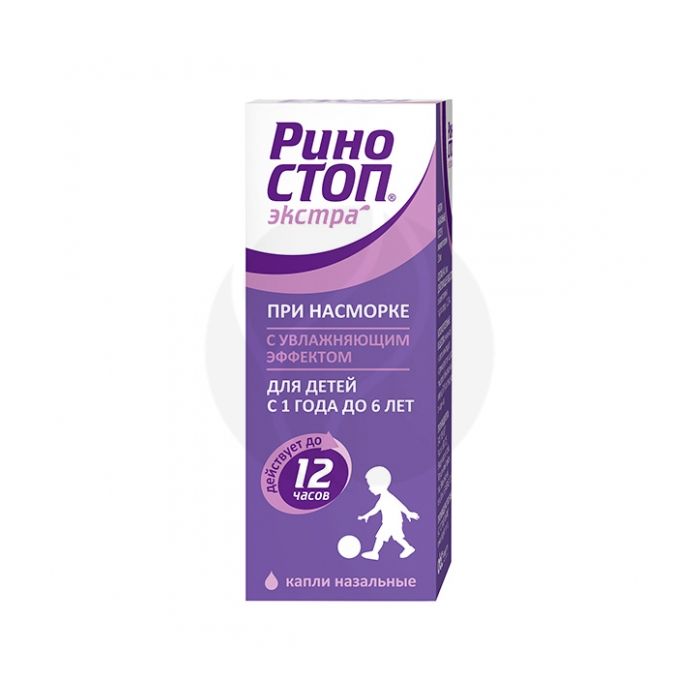Rinostop Extra drops 0.025%, 10ml
Expiration Date: 05/2027
Russian Pharmacy name:
Риностоп Экстра капли 0.025%, 10мл
Treatment of acute respiratory diseases accompanied by rhinitis (runny nose);
allergic rhinitis;
vasomotor rhinitis;
to facilitate the outflow of discharge from the paranasal sinuses with sinusitis, eustachitis, otitis media;
to eliminate edema before diagnostic manipulations in the nasal passages.
Intranasally.
Adults and children over 6 years old: - Apply 1 - 2 drops of a 0.05% solution in each nasal passage 2 - 3 times a day.
Children from 1 to 6 years old: apply - 1 - 2 drops of 0.025% solution in each nasal passage 2 - 3 times a day.
Children under one year old: children under 4 weeks old - 1 drop of 0.01% solution in each nasal passage 2 - 3 times a day. From the 5th week of life to 1 year - 1-2 drops in each nasal passage 2-3 times a day.
In the recommended dose, without consulting a doctor, use for no more than 5-7 days. If symptoms worsen or do not improve within 3 days, you should consult your doctor.
Nasal drops in the form of a clear, colorless or yellowish solution.
1 ml
oxymetazoline hydrochloride 0.25 mg
Excipients: citric acid monohydrate - 0.6093 mg, sodium citrate dihydrate - 3.823 mg, glycerol - 24.348 mg, benzalkonium chloride 50% - 0.1 mg, purified water - up to 1 ml.
Atrophic rhinitis;
hypersensitivity to the components of the drug;
angle-closure glaucoma;
condition after transsphenoidal hypophysectomy;
surgical interventions on the dura mater (in history);
children under 1 year old - for drops of 0.025%;
children under 6 years old - for drops of 0.05%.
Carefully:
In patients taking monoamine oxidase inhibitors (MAO) and other drugs that increase blood pressure (including in the period up to 14 days after their cancellation); in patients with concomitant severe forms of cardiovascular diseases (arterial hypertension, coronary heart disease, chronic heart failure, tachycardia, arrhythmias); with hyperthyroidism, diabetes mellitus, pheochromocytoma, prostatic hyperplasia with clinical manifestations (urinary retention), severe atherosclerosis, porphyria, during pregnancy and during breastfeeding, with increased intraocular pressure, chronic renal failure, in patients taking tricyclic antidepressants, and bromodepressants as well as other drugs that increase blood pressure.If you have one or more of the above diseases and conditions, then you should consult your doctor before taking the drug.
Pharmacodynamics
The remedy for the common cold RinostopЃ Extra (oxymetazoline) has a vasoconstrictor effect. When applied topically to the inflamed mucous membrane of the nasal cavity, it reduces swelling, nasal congestion, nasal discharge, eliminating the symptoms of rhinitis. Restores nasal breathing. Elimination of edema of the nasal mucosa helps to restore aeration of the paranasal sinuses, middle ear cavity, which prevents the development of bacterial complications (sinusitis, sinusitis, otitis media). With local intranasal application in therapeutic concentrations, it does not irritate and does not cause hyperemia of the nasal mucosa.
Glycerol in RinostopЃ Extra promotes moisture retention, which helps to provide hydration to dry or irritated nasal mucosa.
The drug begins to act quickly (within a few minutes). The duration of action of RinostopЃ Extra is up to 12 hours.
Pharmokinetics
With local intranasal application, the drug does not have a systemic effect.
The half-life of oxymetazoline with its intranasal administration is 35 hours. 2.1% of oxymetazoline is excreted by the kidneys and about 1.1% through the intestines.
Overdose
In case of accidental ingestion of the drug or an overdose, the following symptoms may appear: anxiety, anxiety, hallucinations, convulsions, a decrease in body temperature, lethargy, drowsiness, coma, narrowing or dilated pupils, fever, sweating, pallor, cyanosis, palpitations, bradycardia, arrhythmia, cardiac arrest, increased blood pressure, decreased blood pressure, nausea, vomiting, respiratory depression, respiratory arrest.
Treatment: gastric lavage, intake of activated carbon; symptomatic.
Side effects
Burning or dryness of the mucous membranes of the nasal cavity, dryness of the mucous membranes of the mouth and throat; sneezing; an increase in the volume of secretions released from the nose; nose bleed; after the effect of the drug has passed, a feeling of nasal congestion (reactive hyperemia).
Side effects due to the systemic effect of the drug (if the solution is accidentally taken orally): increased blood pressure, headache, dizziness, palpitations, tachycardia, anxiety, anxiety, fatigue, drowsiness, sedation, irritability, sleep disturbance (in children), nausea , insomnia, exanthema, hallucinations, Quincke's edema, itching, convulsions, respiratory arrest (in infants). Visual impairment (in case of eye contact).
Long-term continuous use of vasoconstrictor drugs can lead to tachyphylaxis, atrophy of the nasal mucosa, and recurrent swelling of the nasal mucosa (rhinitis medicamentosa).
If you experience any of the side effects indicated in the instructions or other side effects that are not listed in the instructions, consult your doctor.
Special conditions
Long-term use and overdose of the drug should be avoided, especially in children.
Avoid getting the drug in the eyes.
In order to avoid the spread of infection, it is necessary to use the drug individually.
Influence on the ability to drive vehicles and mechanisms.
After prolonged use of remedies for the common cold containing oxymetazoline, and in doses exceeding the recommended ones, a general effect on the cardiovascular system and the central nervous system cannot be ruled out. In these cases, it is recommended to be careful when driving vehicles and engaging in other potentially hazardous activities that require increased concentration of attention and speed of psychomotor reactions.
Drug interactions
Slows down the absorption of local anesthetic drugs (lengthens their effect when conducting surface anesthesia).
The combined use of other vasoconstrictor drugs increases the risk of side effects.
With the simultaneous use of MAO inhibitors (including the period within 14 days after their cancellation), tricyclic antidepressants and bromocriptine - the risk of increased blood pressure.

